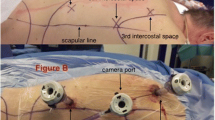Abstract
Background
The phenomenal progress of minimally invasive surgery has imparted its influence on conventional esophagectomy. Currently, more esophagectomies are being performed by laparoscopic and/or thoracoscopic methods. Esophagogastrectomy for the adenocarcinoma of the gastroesophageal (GE) junction has been a conventional treatment. The literature is limited regarding the laparoscopic approach to esophagogastrectomy. The aim of this study was to evaluate the outcome of laparoscopic esophagogastrectomy in the management of adenocarcinoma of the GE junction.
Methods
From January 1997 to February 2005, laparoscopic esophagogastrectomy was performed in 32 patients. Indication for operation was adenocarcinoma of the GE junction in all patients. Neo-adjuvant therapy was used in two patients (6.88%) only. Initially, our approach to intrathoracic anastomosis without thoracic and cervical access was to introduce the anvil of circular stapler through minilaparotomy incision (n = 22), but later we switched to trans-oral placement of anvil into the distal end of the esophagus (n = 10).
Results
There were 22 men and 10 women. Median age was 61.8 years (range, 39–72). There was no conversion. The laparoscopic esophagogastrectomy was completed in all patients. The pyloromyotomy and feeding jejunostomy were performed in all cases. The median intensive care unit stay was 1 day (range, 1–28); hospital stay was 7 days (range, 5–42). Mean estimated blood loss and mean operative time were 150 ml and 200 min, respectively. At mean follow-up of 14 months (range, 2–40), stage-specific survival was similar to that of other series.
Conclusion
In selected cases of adenocarcinoma of the GE junction, laparoscopic esophagogastrectomy offers as good as or better results than open operation in our institution with extensive advance endoscopic and open experience. This study shows that laparoscopic esophagogastrectomy has potential to meet oncologic criteria of clearance and provide the benefits of minimally invasive surgery as well.




Similar content being viewed by others
References
Bonavina L, Incarbone R, Bona D, Peracchia A (2004) Esophagectomy via laparoscopy and transmediastinal endodissection. J Laparoendosc Adv Surg Tech A 14: 13–16
Costi R, Himpens J, Bruyns J, Cadiere GB (2004) Totally laparoscopic transhiatal esophago-gastrectomy without thoracic or cervical access. The least invasive surgery for adenocarcinoma of the cardia? Surg Endosc 18: 629–632
Cuschieri A, Shimi S, Banting S (1992) Endoscopic oesophagectomy through a right thoracoscopic approach. J R Coll Surg Edinb 37: 7–11
DePaula AL, Hashiba K, Ferreira EA, de Paula RA, Grecco E (1995) Laparoscopic transhiatal esophagectomy with esophagogastroplasty. Surg Laparosc Endosc 5: 1–5
Ellis FH Jr, Gibb SP, Watkins E Jr (1988) Limited esophagogastrectomy for carcinoma of the cardia. Indications, technique, and results. Ann Surg 208: 354–361
Ellis FH Jr, Heatley GJ, Krasna MJ, Williamson WA, Balogh K (1997) Esophagogastrectomy for carcinoma of the esophagus and cardia: a comparison of findings and results after standard resection in three consecutive eight-year intervals with improved staging criteria. J Thorac Cardiovasc Surg 113: 836–848
Enzinger PC, Mayer RJ (2003) Esophageal cancer. N Engl J Med 349: 2241–2252
Hennessy TP, Keeling P (1987) Adenocarcinoma of the esophagus and cardia. J Thorac Cardiovasc Surg 94: 64–68
Johnstone PA, Rohde DC, Swartz SE, Fetter JE, Wexner SD (1996) Port site recurrences after laparoscopic and thoracoscopic procedures in malignancy. J Clin Oncol 14: 1950–1956
Luketich JD, Alvelo-Rivera M, Buenaventura PO, Christie NA, McCaughan JS, Litle VR, Schauer PR, Close JM, Fernando HC (2003) Minimally invasive esophagectomy: outcomes in 222 patients. Ann Surg 238: 486–495
Luketich JD, Schauer PR, Christie NA, Weigel TL, Raja S, Fernando HC, Keenan RJ, Nguyen NT (2000) Minimally invasive esophagectomy. Ann Thorac Surg 70: 906–912
Marshall (1938) Carcinoma of the esophagus: successful resection of lower end of esophagus with reestablishment of esophageal gastric continuity. Surg Clin North Am 18: 643
Nguyen NT, Follette DM, Lemoine PH, Roberts PF, Goodnight JE Jr (2001) Minimally invasive Ivor Lewis esophagectomy. Ann Thorac Surg 72: 593–596
Nguyen NT, Follette DM, Wolfe BM, Schneider PD, Roberts P, Goodnight JE Jr (2000) Comparison of minimally invasive esophagectomy with transthoracic and transhiatal esophagectomy. Arch Surg 135: 920–925
Nguyen NT, Roberts P, Follette DM, Rivers R, Wolfe BM (2003) Thoracoscopic and laparoscopic esophagectomy for benign and malignant disease: lessons learned from 46 consecutive procedures. J Am Coll Surg 197: 902–913
Oshawa T (1933) The surgery of the oesophagus. Nippon Geka Hokan 10: 605
Palanivelu C (2002) Laparoscopic esophagogastrectomy. In: Palanivelu C (ed) Textbook of laparoscopic surgery. GEM Foundation, Coimbatore, India, pp 293–300
Rizk NP, Bach PB, Schrag D, Bains MS, Turnbull AD, Karpeh M, Brennan MF, Rusch VW (2004) The impact of complications on outcomes after resection for esophageal and gastroesophageal junction carcinoma. J Am Coll Surg 198: 42–50
Siewert JR, Stein HJ (1998) Classification of adenocarcinoma of the oesophagogastric junction. Br J Surg 85: 1457–1459
Swanstrom LL, Hansen P (1997) Laparoscopic total esophagectomy. Arch Surg 132: 943–949
Watson DI, Davies N, Jamieson GG (1999) Totally endoscopic Ivor Lewis esophagectomy. Surg Endosc 13: 293–297
Acknowledgment
We thank Sister Malalthi Hariharan for providing logistic support.
Author information
Authors and Affiliations
Corresponding author
Rights and permissions
About this article
Cite this article
Palanivelu, C., Prakash, A., Parthasarathi, R. et al. Laparoscopic esophagogastrectomy without thoracic or cervical access for adenocarcinoma of the gastroesophageal junction. Surg Endosc 21, 16–20 (2007). https://doi.org/10.1007/s00464-005-0418-9
Received:
Accepted:
Published:
Issue Date:
DOI: https://doi.org/10.1007/s00464-005-0418-9




